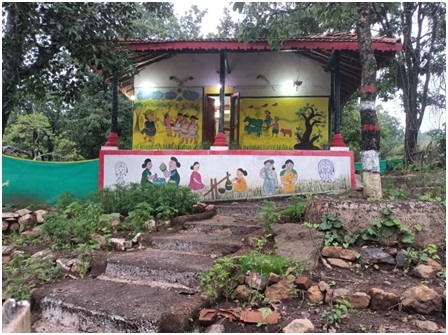Youths Of Patalkot Striving To Keep Adivasi Tradition And Use Of Ayurvedic Medicine Alive
16 Jul 2025 16:37:34

Patalkot (Chhindwara) : Being aware of the fact that development may
sometimes lead to the degradation of tribal culture and traditions, thousands
of people from the Bharia Adivasi tribe living at Patalkot, 200 km away from
Bhopal have rolled up their sleeves to ensure the existence of their culture,
tradition and importance of ayurvedic medicinal values.
Patalkot is a valley known for its rare medicinal plants and herbs, and
the local Bharia tribe utilizes around 220 plant species for medicinal
purposes.
It is a tiny region consisting of 12 villages, and home to thousands
of the Particularly Vulnerable Tribal Groups (PVTGs) population from the
Adivasi community.
The region located at least 1500 feet below sea level was cut off from
the mainland till they got proper roads, communication facilities, an
educational & healthcare system, and electricity in the last 11 years.
The Mobile Medical Unit (MMU) reaches to the last mile at Patalkot
providing emergency medical services. However, people like Balsi Khamaria, and
Ruplal Panram are still continuing their traditional business of ayurvedic
medicine.
continuing their traditional business of ayurvedic medicine
Balsi Khamaria and Ruplal Panram are continuing their traditional
business of ayurvedic medicine in Patalkot.
(ETV Bharat)
“I am running the traditional business of ayurvedic medicine for the
villagers here. If there is any urgency, they come to me for treatment,” said
Balsi Khamaria, a vaid from Patalkot to ETV Bharat.
Medicinal plants like silajit, white musli, bijasar, keokand, jungle
adrak and many others are available at Patalkot.
“We are trying to plant more such plants having medicinal values in our
area,” said Balsi.
He said that on many occasions, private ayurvedic pharma companies set up
camps at Patalkot.
“They purchase medicinal plants from us. However, we appeal
to the Government of India especially the Ayush Ministry to give us an
opportunity to use the traditional plants available here for wider
experimentation so that these ayurvedic plants can be used for treating serious
diseases,” said Balsi.
It is worth mentioning that Sanath Jayasuriya, the Sri Lankan cricketer,
sought treatment for a knee ailment from Dr Prakash Tata, an Ayurvedic doctor
in India who sources herbs from the Patalkot.
Like Balsi, several other educated youths are living at Patalkot who want
to contribute to ensuring the safety, security and protection of the Bharia
tribe at Patalkot.
“As our villages have been witnessing development for the last few years,
there is also an increase in erosion of our land. We have started planting
trees which can not only protect the land but also make us financially stable,”
said Rabindra Bharti, a science graduate from Patalkot.
According to Bharti, they have started planting mango, and java plum
among others. Sirju Panra and her husband Ruplal Panram have also built a
homestay at Patalkot for the tourists.
“We take Rs 3,000 for one day at our homestay. We provide the tourists
with home-made indigenous local food and all modern facilities so that they can
enjoy the village life of the Adivasi community here,” said Sirju.
Talking about the facilities provided by the government for the welfare
of the tribal population here, Manish Borkar from the Tribal Welfare Department
of Chhindwara district in Madhya Pradesh said, “We have provided them with
basic necessities including drinking water in the form of borewell, roads with
blacktopping, electricity among others.”
He said that the Madhya Pradesh government has also set up a hostel cum
ashram at Patalkot with a total inmate of 180 boys.
“The inmates stay in the hostel here and study till class V before they
pursue their educational career outside Patalkot,” said Borkar.
Keeping their dreams alive, students like Girish Routiya, Kapil and
others want to become doctors, engineers and help the people of their
community.
There are 75 PVTG communities residing in 18 states and one union
territory (Andaman and Nicobar Island). Being aware of the fact that
Particularly Vulnerable Tribal Groups in India face a multitude of threats
including limited access to resources, healthcare, education, and livelihood
opportunities, as well as the erosion of their unique cultures and traditions,
the government has launched Pradhan Mantri Janjati Adivasi Nyaya Maha Abhiyan
(PM JANMAN) for socio-economic development of such PVTG communities.
Madhya Pradesh with 12,28,606 population is leading the list of states
having PVTGs population, followed by 4,93,932 in Andhra Pradesh and 6,21,046 in
Maharashtra.
On November 15, 2023, Prime Minister Narendra Modi launched Pradhan
Mantri Janjati Adivasi Nyaya Maha Abhiyan (PM JANMAN) for the socio-economic
development of 45,56,773 population from 75 PVTG communities residing in 18
states and one UT.
Some of the prominent PVTG groups include Abujh Marias, Abhuj Maria,
Baiga, Bharia, Birhor, Hill Korwa, Kamar and Saharia.